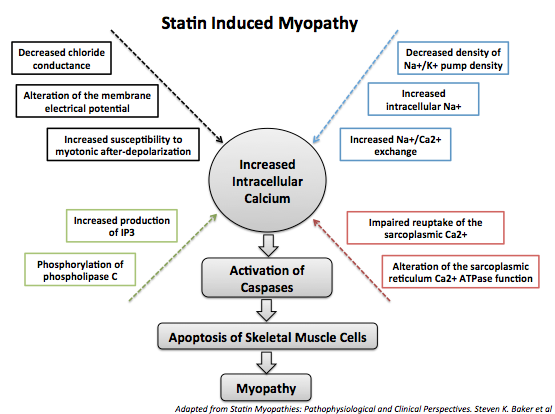Statin induced myopathy: Difference between revisions
Rim Halaby (talk | contribs) |
Rim Halaby (talk | contribs) |
||
| Line 10: | Line 10: | ||
* Myalgia is defined as one or combination of symptoms of muscle weakness, tenderness or pain in the context of normal or minimally elevated creatinine kinase. | * Myalgia is defined as one or combination of symptoms of muscle weakness, tenderness or pain in the context of normal or minimally elevated creatinine kinase. | ||
* Patients usually complain of cramping feeling in the muscles. | * Patients usually complain of cramping feeling in the muscles. | ||
====Asymptomatic increase in creatine kinase==== | ====Asymptomatic increase in creatine kinase==== | ||
Revision as of 21:35, 28 November 2012
Editor-In-Chief: C. Michael Gibson, M.S., M.D. [1]; Associate Editor(s)-in-Chief: Rim Halaby
Overview
Definition
Statin induced myopathy is a spectrum of muscular problems caused by the intake of statin. Myopathy by definition is the any pathology of the muscle. The spectrum of statin induced myopathy includes:
Myalgia
- Myalgia is defined as one or combination of symptoms of muscle weakness, tenderness or pain in the context of normal or minimally elevated creatinine kinase.
- Patients usually complain of cramping feeling in the muscles.
Asymptomatic increase in creatine kinase
Myositis
- Myositis is the inflammation of the muscle.
- Myosisitis is defines as the presence of symptoms of muscle weakness, tenderness or pain in the setting of an elevated creatine kinase up to ten folds.
Rhabdomyositis
- Rhabdomyositis is the acute degeneration of the skeletal muscle.
- It is a potentially lethal condition due to its associated nephrotoxicity caused by myoglobinuria and myoglobinemia.
- Creatine kinase is elevated in rhabdomyosistis more than ten folds the upper normal limits.
- The complications of rhabdomyositis are acute tubular necrosis, hypocalcemia, hyperkalemia, metabolic acidosis, hyperuricemia, DIC and cardiomyopathy.[1]
Other Statin Induced Myopathies
- Elevated creatine kinase after statin withdrawal[2]
- Autoimmune myopathy requiring immunosuppressive therapy[3]
Prevalence
The prevalence of statin induced myopathy, described as a spectrum of clinical conditions ranging from myalgia to myositis and rhabdomyolysis, is almost 10-15%[4]
Risk Factors
- Age more than 80[5]
- Genetics (single nucleotide polymorphism of the gene SLCO1B1)[4]*High dose of statin[4]
- Concurrent use of hepatic cytochrome P450 inhibitors
- Concurrent use of fibrates
- Cerivastatin use especially in combination with gemfibrosil[6]* Major trauma[6]
- Polypharmacy[4]
- Small body size[5]
- Surgery[6]
- Systemic disease
- Liver disease
- Kidney disease
- Diabetes
- Hypothyroidism[5]
Pathophysiology
Statin induced myopathy has a complex poorly understood multifactorial pathophysiology. It is postulated that statin induced myopathy is caused by apoptosis of the skeletal muscle cells because of disrupted intracellular calcium signaling and mitochondrial dysfunction due to depletion of mevalonate metabolism products, notably isoprenoids.[7]
The following changes are caused by statin:
- Changes in cholesterol content and alteration of the membrane fluidity of skeletal muscle cells which disrupts their normal function
- Changes in skeletal muscle cells membrane electrical properties
- Changes in Na+/K+ pump density resulting in decreased production of ATP
- Changes in the excitation-contraction coupling
- Changes in the cell surface receptor transduction cascades
- Decreased synthesis of ubiquinone (Q10), a component of the mitochondrial electron transport chain, leading to decreased ATP production and decreased free radical scavenging
- Increased intracellular calcium causing apoptosis of the skeletal muscle cells[1]
- Decreased mevalonate metabolism products, particularly isoprenoids, leading to a chain of events that culminate in the apoptosis of skeletal muscle cells[7]
- Shown below is an image depicting the mechanism of statin induced myopathy through increasing the intracellular calcium concentration.

Treatment
When symptoms of myopathy or elevation of creatine kinase occur in the setting of a patient taking statin, the majority of patients can safely continue the treatment with statin.
- Patients with asymptomatic elevation of creatine kinase level less than 3-5 times the upper normal level:
- Statin treatment can be safely continued[8]
- Patients with elevation of creatine kinase more than 3-5 times the upper normal level:
- Administration of a lower dose statin
- Alternation in the dosing
- Using twice weekly dosing with longer half lives statins[4]
- Discontinue statin
Monitor creatinine kinase levels.
References
- ↑ 1.0 1.1 Baker, S.K. & Tarnopolsky, M.A. (2001). Statin myopathies: pathophysiologic and clinical perspectives. Clin. Invest. Med., 24(5): 258-272.
- ↑ Thompson PD, Clarkson P, Karas RH (2003). "Statin-associated myopathy". JAMA. 289 (13): 1681–90. doi:10.1001/jama.289.13.1681. PMID 12672737.
- ↑ Radcliffe KA, Campbell WW (2008). "Statin myopathy". Curr Neurol Neurosci Rep. 8 (1): 66–72. PMID 18367041.
- ↑ 4.0 4.1 4.2 4.3 4.4 Harper CR, Jacobson TA (2010). "Evidence-based management of statin myopathy". Curr Atheroscler Rep. 12 (5): 322–30. doi:10.1007/s11883-010-0120-9. PMID 20628837.
- ↑ 5.0 5.1 5.2 Venero CV, Thompson PD (2009). "Managing statin myopathy". Endocrinol Metab Clin North Am. 38 (1): 121–36. doi:10.1016/j.ecl.2008.11.002. PMID 19217515.
- ↑ 6.0 6.1 6.2 Hamilton-Craig I (2001). "Statin-associated myopathy". Med J Aust. 175 (9): 486–9. PMID 11758079.
- ↑ 7.0 7.1 Dirks AJ, Jones KM (2006). "Statin-induced apoptosis and skeletal myopathy". Am J Physiol Cell Physiol. 291 (6): C1208–12. doi:10.1152/ajpcell.00226.2006. PMID 16885396.
- ↑ Blaier O, Lishner M, Elis A (2011). "Managing statin-induced muscle toxicity in a lipid clinic". J Clin Pharm Ther. 36 (3): 336–41. doi:10.1111/j.1365-2710.2011.01254.x. PMID 21414023.